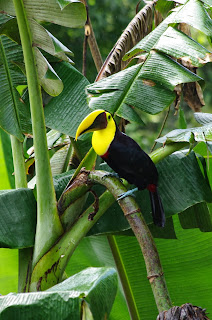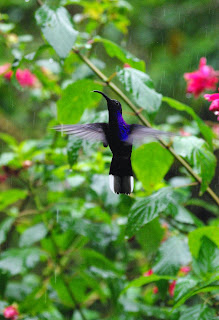One day while standing in my carambola tree hideaway, I was blessed with a wonderful encounter. I was just getting ready to pick some fruit for juicing, when I heard a rustling sound behind me. Not knowing what might be joining me, (a poisonous snake came to mind...), I stood perfectly still. Soon a bird with big orange feet came into view.
 |
| On the mountain, our Tico neighbors don't know the actual name for it, they just call them Pajero Pato, or duck bird. It is more officially known as a Gray Necked Wood Rail. Photo http://naturalencountersbirdingtours.com since all my photos are taken with the bird in the shadows |
Like mandarines, carambola are a fall and winter crop in Costa Rica. During the time that they were in season we would drink our fill of mandarine/carambola juice with our breakfast in the mornings. It was so fresh and delicious! Here in the states, the carambola is expensive, and sub par, being that they are usually picked and shipped green, so they don't normally develop their wonderful sweet, tanginess. But the other day I was checking out a new Publix grocery store near us and saw that they had some promising looking carambola. They were yellow on the edges and pinky orange near the center, just like they were when we picked them on the farm in Costa Rica. They were also on sale at $1.00 a piece, so I cheerfully grabbed a couple so that I could make a tropical fruit juice for Shabbat breakfast.
So this morning, when we had our Sabbath breakfast out in the Lil' Swiss Miss, (our 1957 Swiss Colony camper), which consisted of a bowl heaped with apples, oranges, plums, grapes, kiwi and bananas, we also had a rich and velvety glass of tropical fruit punch. Oh was it good!
I made the juice by running it through our Greenstar juicer, but it can be done about as well, (maybe a little pulpier), in a good blender. Here is the recipe:
Tropical Sunrise Punch
One ripe carambola
Six large mandarine oranges (also known as clementines), or 8 small ones, peeled
One orange, peeled
One very ripe Ataulfo or "champaign" mango (the small golden mango), or 1/2 a very ripe Tommy Atkins,(the large, thick bodied green and red mango), peeled and seeded.
3/4 cup fresh pineapple
0ne carrot
Run through the juicer and serve. If using a blender, blend all until smooth and strain to remove carambola seeds, citrus skins and pineapple and carrot pulp. It can be chilled, but I think the flavor is more pronounced at room temperature. Serves two in goblets, or four in juice glasses.
Sip and enjoy some of the photos I took of the birds that lived with us in Costa Rica!
 |
| Keel Billed Toucan on the farm, Sabalito Costa Rica 2009 |
 |
| Wood Nymph Arenal Observatory, La Fortuna Costa Rica 2009 |







Gorgeous photos and content. I just shared this post with a friend who has a large starfruit tree in her new back yard. She was going to cut it down but I have been trying as hard as I can to be The Lorax and fight for this tree. Your post is lovely and aside from loving Carambola's it will give her a recipe to use the fruit that is apparently abundant. I wonder if you guys live anywhere close to each other? It would be one of those woo-woo moments if you did. You could collect and use the fruit and she could keep that gorgeous tree :). Here's a link to the tree dilema...
ReplyDeletehttp://emilysvegetablepatch.wordpress.com/2013/09/18/the-new-vegetable-patch/
I hope you can convince your friend to keep her tree! Trees that produce food are precious, and the Carambola tree is a lovely tree as well. Also thank you for visiting my blog and for the nice comment. Please come by again!
Delete